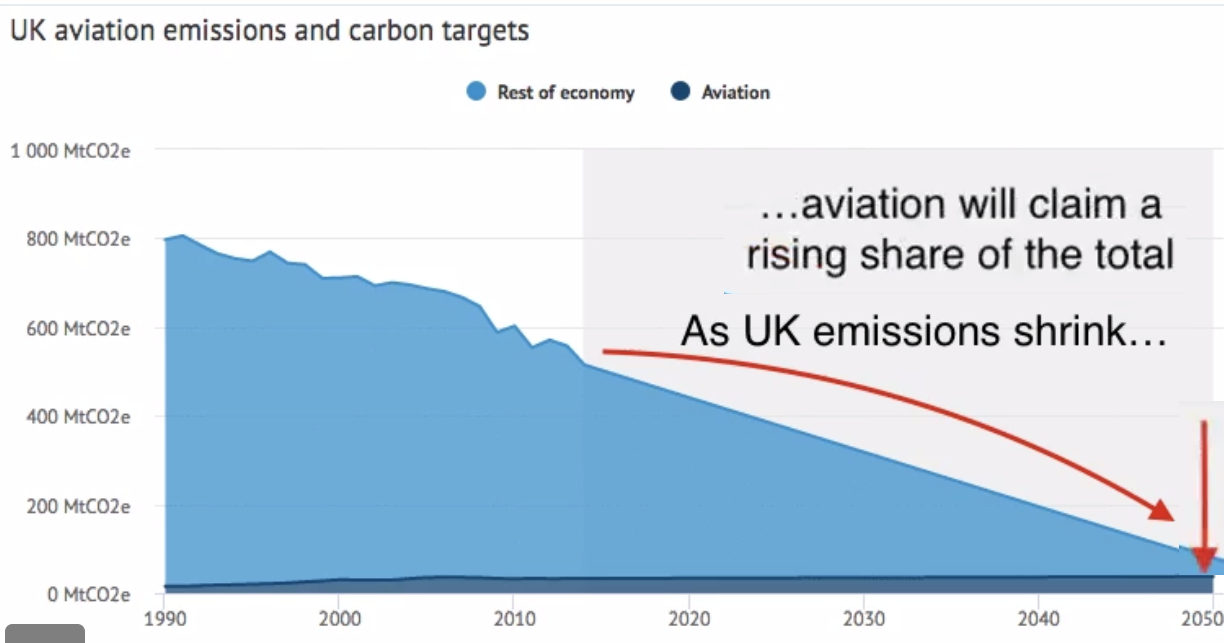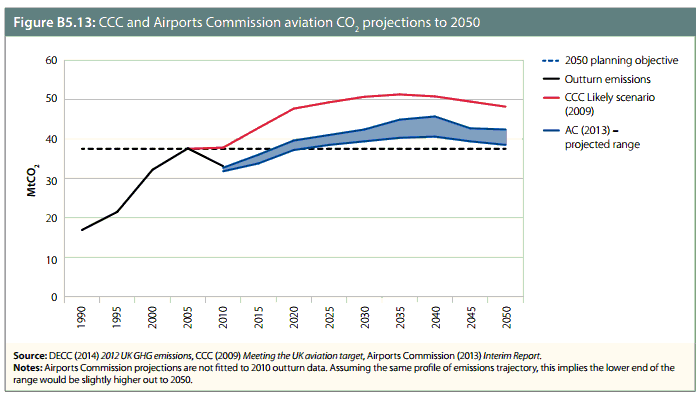BEIS minister admits UK aviation CO2 emissions will not be kept below necessary 37.5MtCO2 level
Replying to a parliamentary question from Zac Goldsmith, BEIS minister Claire Perry revealed that there is no government intention to stick to the limit of 37.5MtCO2 by 2050, as recommended by the government’s advisors, the Committee on Climate Change. Zac Goldsmith’s question: “To ask the Secretary of State for Business, Energy and Industrial Strategy, with reference to page 85 of the Government’s Clean Growth Strategy, what estimate he has made of the actual and projected emissions for the aviation sector for (a) 2030, (b) 2040 and (c) 2050; and what estimate he has made of the required level of aviation emissions if emissions from transport need to be as low as 3 Mt by 2050.” Claire Perry’s reply: “Latest BEIS data shows that carbon dioxide emissions from UK departing flights in 2015 were 34.5 Mt. DfT’s October 2017 aviation forecasts give CO2 emissions from UK departing flights of between 36.6 and 45.7Mt in 2030; between 36.3 and 45.1Mt in 2040; and between 35.0 and 44.3Mt in 2050, depending on demand scenario and airport capacity options. The Government will set out its strategic approach to the aviation sector in a series of consultations leading to the publication of a new Aviation Strategy for the UK. The Strategy will consider what the best approach and combination of policy measures are to ensure we effectively address carbon emissions from aviation.”
.
Tweet
Aviation:
Exhaust Emissions: Written question – 120954
Latest BEIS data shows that carbon dioxide emissions from UK departing flights in 2015 were 34.5 Mt. DfT’s October 2017 aviation forecasts give CO2 emissions from UK departing flights of between 36.6 and 45.7Mt in 2030; between 36.3 and 45.1Mt in 2040; and between 35.0 and 44.3Mt in 2050, depending on demand scenario and airport capacity options.
The Government will set out its strategic approach to the aviation sector in a series of consultations leading to the publication of a new Aviation Strategy for the UK. The Strategy will consider what the best approach and combination of policy measures are to ensure we effectively address carbon emissions from aviation.
The 3 Mt figure quoted from page 85 of the Clean Growth Strategy concerns emissions from transport not including domestic or international aviation and shipping. [ie. domestic].
.
.
The carbon emissions from the UK aviation sector, taking the advice of the government’s advisors on carbon emissions, the Committee on Climate Change, need to be below 37.5MtCO2 by 2050, for the UK to be able to meet its 2050 carbon target.
From this response from Claire Perry it can be seen that the government is not intending to stick to this limit. This has serious implications for the UK carbon target, and for all other sectors of the UK economy.
See also https://www.carbonbrief.org/analysis-aviation-to-consume-half-uk-1point5c-carbon-budget-2050
Illustration below taken from Carbon Brief article above (aviation is dark blue line at bottom):

For example, see the articles below:
Committee on Climate Change says additional policies are needed to keep UK aviation CO2 below 37.5MtCO2 cap
The Committee on Climate Change has produced its advice on the level of the 5th carbon budget, covering the period 2028-2032. The CCC states: “While UK demand for international aviation is likely to grow considerably, emissions must be limited. Previous analysis by the Committee concluded that, based on the available evidence, aviation should plan for its emissions in 2050 to be no higher than those in 2005. That requires strong efficiency improvements to balance demand growth of about 60%.” And …” International aviation emissions should not formally be included in carbon budgets at this stage, though carbon budgets should continue to be set on track to a 2050 target inclusive of these emissions. We will provide further advice following the ICAO negotiations in 2016, and recommend that Government revisit inclusion at that point.” (The CO2 emissions from shipping will be included in the 5th carbon budget.) UK aviation CO2 emissions are currently set to overshoot the 37.5MtCO2 level even without any new runways and to be higher still if a runway is added at either Heathrow or Gatwick. The CCC says in a scenario where emissions are not capped and only low ‘carbon abatement’ options (such as technology improvements) are available, aviation emissions could be as high as 51.9 Mt by 2050, underlining the need for policy action to address the gap.
.
BEIS “Clean Growth Strategy” admits aviation CO2 cannot be kept below 37.5MtCO2 – it has no plan on aviation carbon
The government’s long-awaited Clean Growth Strategy has been published by BEIS setting out how it plans to deliver the carbon reductions needed by the Climate Change Act. BEIS claims that “This strategy sets out our proposals for decarbonising all sectors of the UK economy through the 2020s.” But there’s a huge hole in the strategy – there is no plan for aviation CO2. Despite the Committee on Climate Change repeatedly asking for details of how the sector will keep to within is recommended cap of 37.5MtCO2 pear year, BEIS has been unable to provide any. The Clean Growth Strategy now gives up on the 37.5MtCO2 target, and anticipates the aviation sector emitting 44 MtCO2. Worse than that, in its calculations it lumps in shipping with aviation in that 44 MtCO2 – which presumably is simply an error. The strategy document just says the government “has not reached a final view on the appropriate level of aviation emissions in 2050.” There is not only no policy to limit aviation carbon to the 37.5MtCO2 level, but also no clue how all other sectors could make even greater carbon cuts, to allow for the higher aviation emissions. Cait Hewitt, of AEF, commented that as the government has no proposals or answers on limiting aviation CO2, and there should not be a new Heathrow runway until or unless these are clear.
Click here to view full story…
CCC confirm UK air passenger rise of 60% by 2050 only possible if carbon intensify of flying improves by one third
The Committee on Climate Change has reported to Parliament on progress on the UK’s carbon budgets. They say: “Under the current rate of progress future budgets will not all be met.” Carbon budgets do not currently include emissions from international aviation and shipping, but these are included in the 2050 carbon target. The government will review aviation’s inclusion in carbon budgets in 2016. In 2012 the UK’s international aviation emitted 32 MtCO2, and domestic aviation 1.6 MtCO2. The CCC and the Airports Commission say a new runway can fit within climate targets, but their own figures show aviation growth exceeding the target for decades. Growth in passengers of “around” 60% above 2005 levels could only fit within the carbon target if there is an improvement in the carbon intensity of aviation of around one-third by 2050. The Airports Commission’s own interim report says there can only be 36% growth in flights by 2050, to stay within targets. They say any more growth than that should not happen, “unless and until” there are the necessary technology improvements, cutting aviation emissions. But neither the government, nor the CCC, nor the Airports Commission can pin down what these will be, or when they will happen. UK aviation emissions remain the highest in Europe. 
Click here to view full story…
